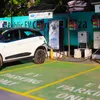Lessons from the Indian electric vehicle market
The Indian EV market’s evolution can be measured by noting the growing number of EV startups — manufacturing everything — from two-wheelers to four-wheelers, hybrid and electric vehicles, e-carts and heavy EVs.
The year 2020 was a rough year for industries worldwide, especially for electric vehicles (EVs), which saw limited domestic production.
However, as the pandemic started getting under control, restrictions eased, and people became more environmentally conscious, the EV manufacturing industry also witnessed confident growth, poised to emerge as one of the leading EV markets globally.
According to reports, the Indian EV market, valued at $1,435 billion in 2021, is expected to reach $15,398 billion by 2027, registering a CAGR of 47.09% during 2022-2027.
The continuous hike in fuel prices is a big motivator for vehicle owners and new buyers to look at cheaper options, and EVs fit the bill. In India, electric mobility will create new electricity demand, helping with a wider introduction of renewable energy in the transport sector.
Besides the more popular benefits — including reducing carbon dioxide emissions and air and noise pollution — EVs also create substantial efficiency gains and could emerge as a storage source for various renewable energies.
The Indian EV market’s evolution can be measured by noting the growing number of EV startups — manufacturing everything — from two-wheelers to four-wheelers, hybrid and electric vehicles, e-carts and heavy EVs.
Through policies, subsidies, and initiatives, several state governments are contributing to boosting EV startups, besides venture capitalists and private equity players, who invest huge funds in automotive startups.
An interesting facet about technology is that once a new technological invention happens in one corner of the world, it soon spreads as others start to adopt the same.
The first-ever automobile was built in the 1800s in Germany and France, but it took virtually no time for the technology to reach America and the rest of the world.
China has now moved quickly to secure a stronghold in the EV market, understanding that EVs would offer a clear course to becoming the foremost player in the global automotive market.
A robust battery manufacturing sector, extensive charging infrastructure, and favourable government policies have propelled European countries like Sweden and Germany to the top.
In India, EV companies have received a huge boost from the government with the introduction of the FAME I and II schemes, the enhancement of e-charging infrastructure, reduction of Goods and Services Tax (GST) on EV purchases, and offering Rs 10,000 crore worth subsidies.
Alongside Production Linked Incentive (PLI) schemes, scrappage policy, and the Make in India initiative, these schemes lay the roadmap for widespread EV manufacturing and adoption in the country.
However, the Indian market is price-conscious. Indian consumers are always looking for value for money, which puts pressure on pricing — a common phenomenon in growing industries.
At times, these pressures can impact the overall quality of the electric vehicle, which needs to be built for Indian conditions, climate, and roads.
The batteries not only need to be compatible with the country’s hot and humid climate but also with extreme road conditions, and a robust Battery Management System (BMS) can ensure safe and reliable performance. Vehicles and components made for colder climates will not work for Indian conditions.
The EV industry is still at a nascent stage in India. We haven’t even seen one entire lifecycle of a single generation of EVs yet. There is a perception that EVs are low on maintenance compared to fuel-powered vehicles. While this is true, there is still some learning to do in maintaining an EV.
Owning an EV requires a behavioural change in terms of maintenance of the vehicle and battery. Therefore, manufacturers must make it a core principle to educate customers about the usage and maintenance of their vehicles.
All these factors contribute towards impacting one key factory — safety. India’s EV revolution will be a success only when all stakeholders approach it through the lens of educating the end-consumer on how safe EVs are for daily use.
OEMs should take steps toward training their sales and after-sales teams for EV-specific vehicles. Meanwhile, the entire ecosystem of government, manufacturers, dealers, and investors must come together to ensure that everyone in the supply chain has significant know-how about handling and maintaining EVs.
Safety cannot be achieved without investing in it. No individual or a single company can marshal such an enormous change on their own. It is up to the key players in the EV ecosystem, including the government, automobile industry, and EV mobility fleet owners, to turn from challenging traditional mobility modes to unconventional ones.
Manufacturers must focus on ensuring consistency in their product quality and keep evolving the technology needed to make EVs safer. The inevitable and much-dreaded cost pressures at the beginning will pay off in the long run. Investment in indigenous technology and its development is imperative.
Indian policymaking also needs an overhaul to ensure India keeps pace with the rest of the world in phasing out gas-powered vehicles and adopting EVs.
Standardisation of technology, specifications of batteries, and other integral parts of an EV more suited to our country will help improve the quality of the products and work in favour of the Indian EV industry.
These actions will also instil confidence in the end customer, help with cost reduction, and improve the adoption of battery swapping and charging technologies — could be accessed by more consumers.
Parallelly, the government needs to take steps and introduce schemes and incentives to ensure everyone gets educated about EVs — from the dealers to the end consumers.
The way a customer handles and uses a vehicle will have a long-term impact on their life and experience. Regular servicing offered by EV manufacturers and dealers will help identify any potential issues with the vehicle.
The EV industry offers a plethora of scope and unique opportunities to revolutionise the way we see commute and transportation.
Right now, the Indian EV industry needs to have a 360-degree approach to ensure the safe and secure mass adoption of EVs.
Since it is the most important factor, safety needs to be the core of all things EVs that will push consumers into buying, ultimately leading to the EV revolution. If India manages to steer itself down this path responsibly, the future of the EV revolution in India could certainly be electrifying.
Edited by Suman Singh
(Disclaimer: The views and opinions expressed in this article are those of the author and do not necessarily reflect the views of YourStory.)










